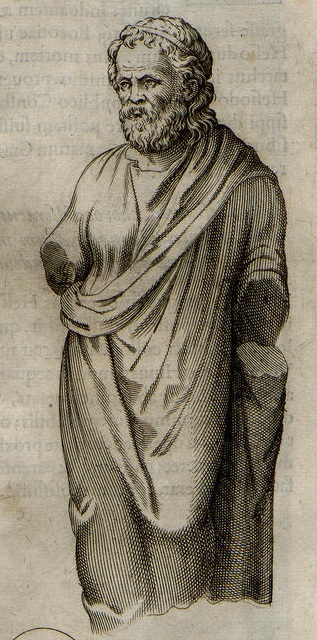Orsini Homer: Difference between revisions
Nick White (talk | contribs) No edit summary |
Nick White (talk | contribs) No edit summary |
||
| Line 7: | Line 7: | ||
'''Object Description''': A statue of Homer known to Fulvio Orsini in the mid-sixteenth century. | '''Object Description''': A statue of Homer known to Fulvio Orsini in the mid-sixteenth century. | ||
'''Discussion''': The illustration suggests a copy in stone rather than bronze because the statue has a support under the left arm proper (a characteristic of marble sculpture on account of its weight rather than lighter bronze). The illustration lends the portrait the appearance of a miniature, though it is hard to discern exactly how, and there is no other evidence as to the size of this object. The statue is broken off beneath the knees, and lacks both arms below the elbow. The figure wears a fillet (which suggests a poetic role), and apparently a chiton (tunic) and himation (cloak). This image has been thought to resemble the ''Apollonius of Tyana Type Homer'', and is used as a criterion for its identification. | '''Discussion''': The illustration suggests a copy in stone rather than bronze because the statue has a support under the left arm proper (a characteristic of marble sculpture on account of its weight rather than lighter bronze). The illustration lends the portrait the appearance of a miniature, though it is hard to discern exactly how, and there is no other evidence as to the size of this object. The statue is broken off beneath the knees, and lacks both arms below the elbow. The figure wears a fillet (which suggests a poetic role), and apparently a ''chiton'' (tunic) and ''himation'' (cloak). This image has been thought to resemble the ''Apollonius of Tyana Type Homer'', and is used as a criterion for its identification. | ||
== Bibliography == | == Bibliography == | ||
Revision as of 09:43, 12 February 2014
Image: Extract from Ursinus, F. 1570. Imagines et Elogia Virorum Illustrium et Eruditorum ex Antiquis Lapidibus et Nomismatibus Expressa cum Annotationibus ex Bibliotheca Fulvi Ursini. Rome. p. 21.
Object Description: A statue of Homer known to Fulvio Orsini in the mid-sixteenth century.
Discussion: The illustration suggests a copy in stone rather than bronze because the statue has a support under the left arm proper (a characteristic of marble sculpture on account of its weight rather than lighter bronze). The illustration lends the portrait the appearance of a miniature, though it is hard to discern exactly how, and there is no other evidence as to the size of this object. The statue is broken off beneath the knees, and lacks both arms below the elbow. The figure wears a fillet (which suggests a poetic role), and apparently a chiton (tunic) and himation (cloak). This image has been thought to resemble the Apollonius of Tyana Type Homer, and is used as a criterion for its identification.
Bibliography
- Cellini, G. A. 2004. Il Contributo di Fulvio Orsini alla Ricerca Antiquaria. Rome.
- Kätzlmeier-Frank, M. 1993. Theodor Galles Zeichnungen zu Fulvio Orsinis Imagines : der Codex Capponianus 228. Münster.
- Richter, G. M. A. 1965. The Portraits of the Greeks I (vol. 1). London. pp. 48-50.
- Richter, G. M. A. and Smith, R. R. R. 1984. The Portraits of the Greeks. London. p. 144

